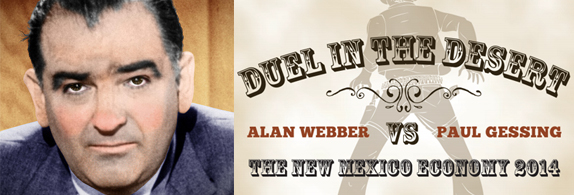Neo-McCarthyism and The Rio Grande Foundation

When you accuse someone of espousing “central planning” ideas and then make an association with Russia, you’re dealing in code words that to Tea Party rebels, denizens of the Libertarian Enlightenment, and the radical rich longing for re-flowering of the John Birch Society mean only one thing -- the “collectivist,” communist menace.
Such neo-McCarthyist thinking is seeping into New Mexico politics.
We heard it last week at the South Broadway Cultural Center in a debate on New Mexico’s economy between former Democratic gubernatorial candidate Alan Webber and Paul Gessing, the president of the Rio Grande Foundation, called The Duel in the Desert. It was a packed house of more than 300 in the John Lewis Auditorium. Most of them were Webber supporters.
One had to wait until the very end of the evening before those ominous code words were uttered. For anyone who has lived through the McCarthy Era and the witch hunts of the House Un-American Activities Committee (HUAC) in the l950s, Paul Gessing’s concluding accusation against Alan Webber that he was a devotee of Russian (read Soviet) style “central planning” sent a creepy shudder up the spine.
It linked Gessing to the appalling oratory and rhetorical flourishes that have recently whipped up the political fanaticism of the Extremist Right.
Richard Fink, described as the top political strategist of the Koch Brothers, told a recent political summit meeting that the minimum wage leads to fascism.
Other speakers warned that “liberalism” leads to totalitarianism like that practiced in North Korea. The Koch summit heard over and over that politics is a war between freedom and collectivism, i.e. “liberalism, fascism, and socialism,” all lumped together.
In keeping with the Koch Industries campaign of climate change denial, speakers called “environmentalism” a form of collectivism, and climate change a cause that gave people with meaningless lives a sense of purpose.
This McCarthy-like insanity is now claiming that communist Cuban intelligence agents are infiltrating American campuses aggressively recruiting “leftist academics” and university professors to spy for Cuba, according to the far right news site Washington Free Beacon. Are we going to see the re-emergence of loyalty oaths next?
The Rio Grande Foundation over which Gessing presides is linked to the world of “libertarian” anti-government, pro-business politics. According to Source Watch, it receives funding from the Cato Institute, a libertarian organization with funding from the Koch brothers. Source Watch reports that The Rio Grande Foundation has ties with the American Legislative Exchange Council (ALEC), a group which busies itself with rounding up freshman congressmen to explain to them how they will vote and what issues they are to bring before Congress.
The Duel in the Desert, itself, was good political entertainment. Statistics were flying right and left. Graphs and charts were flashed on the screen by Gessing as if they were announcing arrivals and departures of trains. Most people thought Webber wiped the floor with Gessing, and I’d agree.
Webber’s case that Governor Martinez has come close to stagnating New Mexico’s economy to death was his vintage campaign speech from the Democratic primaries earlier this year. Under Governor Martinez’s watch, New Mexico is one of the few places in the nation not recovering from the recession of 2008. Webber contended New Mexico lost a bid to get a huge Tesla plant because the governor does nothing to support renewable energy which Tesla pioneers. She’s vetoed the minimum wage, harassed teachers, hacked off the film industry, and has failed to raise New Mexico’s bottom feeding status after four long years. You can read his views in an earlier written argument with Gessing.
Gessing countered with an argument that New Mexico has always been poor, and that it always will be, that it’s always been run by Democrats (who, he failed to mention, were elected to office}, that the governor was not a queen and couldn’t do much without legislative support, and that New Mexico’s real problems come from a lack of “economic freedom,” meaning that it is not a “right to work” state. In other words, it has no union-busting laws on its books.
You can catch the whole debate on ProgressNow New Mexico’s Youtube page.
The Duel in the Desert was a sort political sideshow between proxies who represented political camps if not candidates. The main circus tent still remains empty a full week and counting after Labor Day. The Governor and her challenger Attorney General Gary King are literally nowhere to be seen. The huge crowd at the sideshow demonstrated how eager voters are for something – virtually anything – from the major players.
Political reporter and analyst Joe Monahan, in his September 9 blogpost, appears to be right. The Democrats could well have written off the governor’s race. Webber didn’t mention Gary King a single time in the debate. And Gessing only glancingly referred to King with dismissive disparagements. If the old advertising saw that “any mention is a good mention” is true, then Martinez herself was the winner of sorts in the Duel in the Desert, as her name was the most frequently spoken word of the night.
A sideshow or not, the Duel in the Desert might be the only show in town for many weeks. And it gave the audience a renewed understanding of the perennial spectrum of American domestic politics – from FDR to Reagan, from an empathetic emphasis on raising the quality of life for all to a coldblooded quantitative amassing of wealth for the few. It’s been like this in our country almost from the start – a contest between those exclusivist elites who believe money and property equal political wisdom and virtue against those populist inclusivists who value equal opportunity, hard work, and public service.
While Webber represents a currently disorganized point of view with a long and often noble tradition of fairness battling against privilege, Gessing represents a world view with a machine-like efficiency and a vast war chest in the service of self-interest that defines the public good as somehow being a danger to freedom.
Biases abound, of course, and I’m no different. But I wish the two main contenders would take notice of the Webber and Gessing duel and have it out in the main tent a dozen or more times over the next eight weeks. But that’s as likely as the Governor coming out in favor of programs and incentives to promote good teaching that empowers student’s curiosities rather systems that require teachers to be coaches imparting the limited skills required to do well on tests.
Climate Change: Turning a Blind Eye

While thinking people in the rest of the country and the world, and the vast majority of the scientific community, are profoundly concerned about climate change and its potentially overwhelming consequences, political players in New Mexico, even the best of them, have turned a blind eye and deaf ear to the whole ghastly scenario that’s unfolding before us.
On the modest left the quest for “jobs” has eliminated the discussion of virtually anything else. On the fanatic right climate change is denied and those who talk about it are penned up intellectually in the classification of “collectivists” and people who are against “economic liberty.”
And all this in the face of a UN report which confirms, to no one’s direct financial advantage it would seem, that climate change is coming faster and more intensely than we thought and could swamp our major cities, cause worldwide food shortages and outright famines and displace millions of people. The Tsunami keeps on heading for shore. And we’re drinking G and Ts on the beach.
The mayor and city council of Albuquerque, and most major cities in the state including Santa Fe, won’t even discuss the climate-change caused drought we’re in, or our diminishing water supply. And the Martinez administration simply ignores the environment as an existing reality at all. Our leaders are living in a Never-Never Land. And the real world is on the edge of the abyss.
One never hears a whisper of the over-heated atmosphere and what it might mean to life and death in our state and how we might adjust to make the future around the corner less dangerous and destructive than it might otherwise be. Oil and gas still fund some 30% of the state’s budget. It funds us while it adds carbon to the atmosphere which is drying New Mexico and the rest of the west into little patches of expensive dust.
Are we like Romans who continued going to the gladiatorial combats when the barbarians were clamoring at the gates of their cities, preferring blood sports to survival combat, oblivious and headed toward oblivion?
It’s not as if climate change is really a matter of debate anymore. Droughts in the Colorado River Basin, equatorial monsoons in Phoenix, the desiccation of California all strongly indicate that the climate is not only changing all over the world, melting glaciers, shrinking the icepack on Greenland, shrinking sea ice in winters at the poles, but it’s happening here too with drought, unpredictable ferocious inland storms and perhaps megadroughts as the new norm.
The New York Times last month cited a soon to be released United Nations climate report stating that if greenhouse gas emissions weren’t cut back severely, and very soon, that “climate extremes could intensify” and become unstoppable. The report noted that “the risk of abrupt and irreversible change increases as the magnitude of the warming increases.”
The World Meteorological Organization (WMO) reported recently that greenhouse gas concentrations grew last year at the fastest rate since reliable global records began. The WMO asserted that, “We know without any doubt that our climate is changing and our weather is becoming more extreme due to human activities such as the burning of fossil fuels … Pleading ignorance can no longer be an excuse for not acting.”
In a series of stark portraits of deeply worried climate change scientists, photographer Nick Bowers interviewed and photographed scholars as they discussed their findings. The most moving of the images is of biologist Shauna Murray from the University of New South Wales. She told Bowers:
We’ve recorded all sorts of climate change shifts in multiple areas. However, the scientific process is consistent. Every single individual study that has been done, has gone through the same rigorous process, data collection, research analysis, and qualified peer review. At the moment we’ve at least 10,000 different papers, completed over 20 years, each using different data sets, and they are all coming to the same climate change conclusions. We’ve a weight of evidence that the average person is simply not aware of – and this frightens me…
And what kind of actions might be appropriate for elected leaders and their staffs to take to prepare their state and its cities to adapt to the extremes ahead? We could see legislation and funding around the development of gray water and black water treatment and delivery infrastructure, desalination and the safe storage of its waste, incentives for decentralizing renewable energy sources with private solar and wind generating electrical systems, a statewide water conservation strategy planned in conjunction with area cities, storage facilities and flood plane reconnection systems to make use of massive amounts of monsoon water, and mandatory drought and water conservation educational programs in public schools.
And that’s just a beginning.
But why aren’t we starting?
Why We Love New Mexico – Arts and Culture

Even for nonconformists, a surprisingly compelling reason to love New Mexico is that so many talented and creative people love it too.
Painters, poets, writers, musicians, sculptors, print makers, weavers, collage makers, song writers, actors, singers, dancers, curators, architects, designers, librarians, and a host of other gifted people reside here in such profusion that they play a major part not only in our economy, but also in the intellectual and creative atmosphere that pervades our state. The Mercury, alone, has been graced with the generosity and talent of over l70 contributors in the 17 months of its existence.
Such people fill New Mexico with the energy and passion of those who do what they love because they love doing it. And our creative community is so large and represents such an enduring and empowering force of imagination in the lives of all of us, that New Mexico really can be said to be a place where inspiration, innovation, insight, and often transcendent intuition infuse our daily lives with opportunities for joy and appreciation as powerfully as any other place in the modern world.
And this reality shows up to some extent in New Mexico’s economy, though most artists and writers are self-employed and often impoverished. In a recent study by the University of New Mexico Bureau of Business and Economic Research, commissioned by the New Mexico Department of Cultural Affairs, investigators found that “arts and culture industries” are “the primary source of employment for 43,031 New Mexicans – roughly equal to the state’s construction industry and 50% larger than the manufacturing industry.”
The study concluded that if the arts and culture “industries” included “cultural tourism, arts, and cultural education and industries linked to the unique culture and heritage of the state,” the employment numbers would rise to 76,780 people, “equal to about one in ten (9.8%) jobs in the state.”
It’s unclear to me if the study includes the legions of self-employed art, literature and music makers and other people in the performing arts. Anyone who works in these “industries” knows how brutal the economic realities of creative work can be. And many are aware how other businesses in New Mexico, non-creative businesses, exploit the aura and the “cultural richness” that the arts community creates in our state. In fact the “arts and culture industry” is really made up of two kinds of workers, those employed by non-profits and businesses with health insurance and other benefits, and those who are self-employed with no benefits, no insurance, and complete vulnerability to the vagaries of the marketplace.
While the inspirational reality of New Mexico’s creative life enriches us all, there will always be the ugly paradox of income and safety net inequality running through the creative community. Only when that is rectified can the economic benefits of “arts and culture” be accurately assessed.
(Photos: Joe McCarthy by DonkeyHotey; Climate change by Mario Piperni; Mural by City of Albuquerque Public Art)




Responses to “Provincial Matters, 9-15-2014”